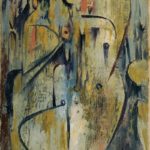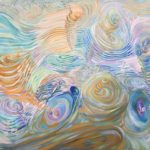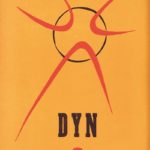Subscribe to Our Newsletter
Wolfgang Paalen: The Painter of the Possible
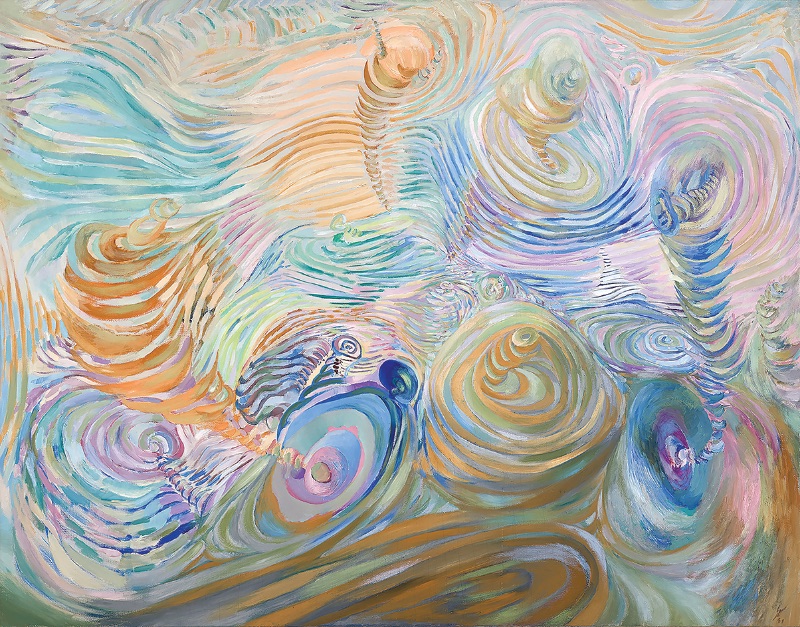
Wolfgang Paalen, artist, art theorist, and expert on tribal art, looked to the ancient past while charting a course for the future.
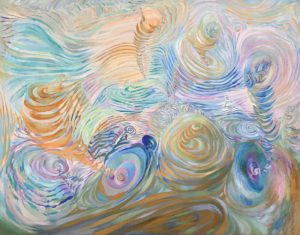
Wolfgang Paalen, Espace libre, 1941, oil on canvas, 114 x 145 cm.
- Wolfgang Paalen, El Velorio, 1946, oil on canvas, 34 x 25 cm.
- Wolfgang Paalen, Espace libre, 1941, oil on canvas, 114 x 145 cm.
- Wolfgang Paalen, Cover of DYN magazine, No. 3, Fall 1942
In the life and career of Wolfgang Paalen, three roles twine together inseparably and, in the end, fatally—the artist, the theorist, and the collector. A painter who allied himself with Surrealism in the 1930s and then quit the movement, Paalen was a prolific writer who published a journal of art and theory that proved to be influential with American abstract artists after World War II. He was also a passionate collector and scholar of Cycladic, Northwest Coast, and Pre-Columbian art, which he prized not only for aesthetic qualities but also as a source of inspiration. For Paalen, archaic artworks were signposts along the road of human achievement, pointing not only backward but ahead, toward a future of untrammeled creativity.
A Paalen retrospective will be on view from October 4–January 19 at the Belvedere in Vienna, the artist’s native city. “Wolfgang Paalen: An Austrian Surrealist in Paris and Mexico,” curated by Andreas Neufert and Franz Smola, places on view paintings, drawings, and Surrealist objects, along with archival photographs and documents, to encapsulate a life in pursuit of what Paalen (quoting Aristotle) called to dynaton, Greek for “the possible.”
The artist of the possible was born into a dying world, that of the old Austro-Hungarian Dual Monarchy, in 1905. His father, Gustav Robert Paalen, was an inventor and merchant who patented and marketed the Thermos bottle and the vacuum cleaner, which brought him great wealth and fame. Of Jewish origin, he changed his last name from Pollak in 1900, converted to Christianity, and was admitted into Austrian upper-class society, eventually being granted noble status by the Emperor. Wolfgang grew up between Vienna and his family’s castle in Silesia, immersed in fin-de-siècle high culture. His parents’ houseguests included Gustav Mahler and Walter Gropius, and Robert Paalen was a major collector of Old Master paintings. There was another family inheritance—mental illness. Wolfgang’s beloved brother Rainer shot himself in the head right in front of him (although he survived the wound to die 10 years later), and his other brother, Hans-Peter, died in an insane asylum, presumably of suicide. Their German-born mother, an actress, suffered from bipolar disorder after World War I—in which Gustav Paalen helped both the Austro-Hungarian and German governments with logistics—the Paalens moved to Rome. There, Wolfgang studied with a classical archaeologist, becoming a precocious expert in Greek and Roman art and kicking off a lifelong fascination with the art of the ancient world. In 1922 he began art studies in Berlin and soon showed Impressionist-style paintings at the Berlin Secession. By 1924 he was in Paris, absorbing the elements of Cubism and associating with international avant-garde artists such as Max Beckmann. After a stint back in Germany, Paalen returned to Paris in 1929 and stayed there for most of the next decade, during which his art matured and he created what most critics believe to be his best work.
Paalen’s paintings from the early ’30s are abstract, Cubist-influenced, and vaguely biomorphic, with contrasting colors set off by sharp lines. During this phase he joined a group called Abstraction-Création, formed in opposition to Surrealism by artists including Jean Hélion, Theo van Doesburg, and Georges Vantongerloo, and exhibited with them in 1934. Soon, however, he moved over to the Surrealist camp. The Surrealists emphasized automatism as an artistic tool, and Paalen added an arrow to the automatistic quiver of named techniques such as collage, assemblage, frottage, photomontage, and decalcomania. His innovation, dubbed fumage, involved holding a candle up to a piece of paper or canvas so that the smoke, driven only by heat and the breeze, left ghostly gray traces on the surface which could be left as they were or touched up with paint. Although Jackson Pollock later quipped, “I can do that without smoke,” at the time fumage was seen as a key invention and impressed André Breton, who hailed Paalen as a Surrealistic heavy-hitter. Paalen’s involvement with the movement extended to the making of three-dimensional Surrealistic objects or sculptures such as an umbrella made of sponges, a pistol made of bones, and a rotating turntable with glass eyeballs and black feathers. He also helped design an “environment” for a 1938 Surrealist exhibition in Paris, collaborating with Marcel Duchamp and Salvador Dalí.
Another way in which Paalen’s goals coincided with those of the Surrealists was his interest in what was then known as “primitive” art. As early as 1933, Paalen had visited the caves of Altamira, Spain, famous for their Stone Age wall paintings, and around that time he also became obsessed with Cycladic art and started collecting it. For Paalen, archaic art was far more than a passing enthusiasm or a rhetorical device; it determined the course of the rest of his life’s work as a painter and a thinker. And in the art of the Northwest Coast cultures of British Columbia and Alaska, which he discovered around 1938–39, he found the fullest expression of those qualities in archaic art that he felt were valuable to today’s artists.
In Paalen’s view, the art of preliterate or pre-Classical ancient cultures had something of universal value to communicate to us moderns. In common with Franz Boas, who had pioneered Northwest Coast art studies (and with whom he corresponded), Paalen believed that the “plastic” inventiveness and skill of these works was ample proof that artistic greatness was by no means confined to the dominant Western culture. But he went much further than that. In his 1943 essay “Totemic Art,” Paalen argued that Northwest Coast art—Tlingit, Haida, Tsimshian, Bella Coola, among others—embodies an alternative to the modern European “dualistic” mindset, in which human consciousness isolates itself from the world around it. In the archaic phase of perception, everything in the world has a “vital essence,” and in the case of Northwest Coast cultures this experience causes “a facility of totemic identification which does not know the distinctions between human and animal traits.” The archaic mentality in general, “not distinguishing clearly the subjective and objective, itself identifies emotionally with the environing world.” While Paalen was writing as a careful ethnographer and art historian, he was also advocating the adoption of a neo-totemistic approach to the making of art in the modern world.
Paalen, who fled Europe for America just before World War II broke out, made an important collecting trip to the Northwest Coast in 1939, in the company of his wife, the French artist Alice Rahon, and their friend and patron, the Swiss photographer Eva Sulzer. While there, he purchased some important pieces, including a massive Southeastern Alaskan brown-bear totem screen that is one of only five or six remaining in existence, and made contact with the Canadian artist Emily Carr, who was also inspired by totem art, though in a more literal way than Paalen was.
Even before he visited the Northwest Coast, however, Paalen was incorporating its artistic themes in his work. Paintings from the late ’30s hint at figuration with suggestions of lonely barren landscapes and shapes rising against the horizon that could be abstracted totem poles. Fumage-and-paint works from that time feature a deeper sense of space than before, and the plumes of smoke that undulate within that space seem to congeal fleetingly and tantalizingly into animal and bird forms. Through these works, the viewer enters a dream zone in which, as in Paalen’s version of the archaic mentality, distinctions between humanity and nature, observer and observed, past and present dissolve.
During the war and right afterward, Paalen spent time in New York, where he exhibited with Julien Levy and met William Baziotes, Adolph Gottlieb, Barnett Newman, Jackson Pollock, and Robert Motherwell. The latter worked very closely with Paalen for several years and was profoundly influenced by his theories, although in later years he sought to distance himself from them and minimize the extent of their friendship. Paalen’s presence in New York ensured that his ideas had a definite effect on the emergence of Abstract Expressionism, although his contribution is not very well represented in the standard art-historical narrative. He also spent a good deal of time in the San Francisco Bay area, where he and his second wife, the Venezuelan-born artist Luchita Hurtado, joined a circle that included Jean Varda, Henry Miller, Anaïs Nin, Gordon Onslow Ford, and Lee Mullican (for whom Hurtado left him in 1950). With this group of friends Paalen planned an ambitious artistic collaboration called Dynaton, which yielded an exhibition at the San Francisco Museum of Art but ultimately little else.
Despite these undertakings and excursions, Paalen’s home base from 1939 on was Mexico. There he fell in with European artistic exiles and local avant-gardes including Diego Rivera, Frida Kahlo, Miguel Covarrubias, Manuel Álvarez Bravo, and César Moro. While living in and around Mexico City, Paalen published a journal called DYN, and although it only went through six issues, it had a major impact on both the artistic and scholarly worlds. DYN was beautifully designed and produced, with cover art by Paalen and others, and its contents combined art theory, physics, anthropology, and archaeology. Issues 4 and 5 (December 1943) were combined into a special double-sized “Amerindian Number” devoted to Native American art both North American and Pre-Columbian. Among its contents were Paalen’s seminal “Totemic Art” essay and several color illustrations by Covarrubias, a Mexican artist who also achieved real distinction in the field of anthropology. After leaving Europe for the New World, Paalen had split with Breton and the Surrealists, and in fact DYN was seen as a rival to Breton’s New York-based publication VVV.
In his Mexican exile, Paalen continued to produce art as well as literature. His paintings from this period abandon the eerie spaces of the prewar work in favor of a rougher, more “allover” style akin to Abstract Expressionism. The intricate play with patterns in many of these late works attests to Paalen’s concern with the nature of vision and perception in general. Perhaps because of his distance from the New York art world, perhaps because of his growing mental instability due to bipolar disorder, Paalen was having a hard time selling these works. To make a living, he relied increasingly on selling Pre-Columbian art to American collectors, and this sideline as an antiquities dealer led him into some perilous waters. It appears that he was involved in illegal transactions, and fear that these would be exposed may have contributed to the depression that led to his suicide. On September 24, 1959, he shot himself in the head on a remote hillside in Taxco, Mexico, and his body was not found until days later.
The artist Ad Reinhardt drew a famous cartoon in 1952 called How to look at a cubist painting?, in which a man confronts an opaque-seeming modernist canvas, asking, “Ha ha, what does this represent?” The painting assumes an angry face and points back at him with the retort, “What do you represent?” While this comes across as a whimsical joke, it is in fact a near-transcription of a statement from an essay by Wolfgang Paalen: “It is the painting which, in turn, examines and interrogates the spectator: what do you represent? Painting is not a trade, but a way of meditating on the world which makes and unmakes us.”
For Paalen, art was not about representing a world separate from the consciousness that is perceiving it, nor was it a navel-gazing introspection into the human psyche without reference to world outside it. Drawing inspiration from the most ancient ways of representing ourselves and our worlds, Paalen looked forward to a time when we can fulfill all the possibilities, when, as he put it, past and future almost touch. In an essay about his Northwest Coast journeys, he wrote, “Works of art are traps set for life—if the trap is well set, life is snared within it forever.” In his too-short career, he set many traps well.
—-
By John Dorfman

